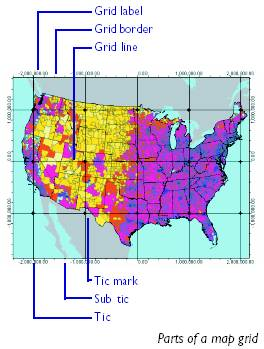

Main Entry: ↑grid … Useful english dictionary.
#Define grid mapping series#
Grid reference - noun A series of numbers and letters used to indicate the precise location of a place on a map In order to give a standard 6-figure grid reference from a 10-figure GPS readout, the 4th, 5th, 9th and 10th digits must be omitted so it is important not to read just the first 6 digits. Since, in the UK at least, a 6-figure grid reference identifies a square of 100-metre sides, an 8-figure reference would identify a 10-metre square, and a 10-digit reference a 1-metre square. Each successive increase in accuracy (from 6 digit to 8 digit to 10 digit) pinpoints the location by a factor of 10. A GPS unit commonly gives a ten-digit grid reference, based on two groups of five numbers for the Eastings and Northing values. The growing availability and decreasing cost of handheld GPS receivers enables determination of accurate grid references without needing a map, but it is important to know how many digits the GPS displays to avoid reading off just the first six digits. This might be used in surveying but is not generally used for land navigating for walkers or cyclists etc. Grid references comprising larger numbers for greater precision could be determined using large-scale maps and an accurate Romer.

The symbols on the map are not precise in any case, for example the church in the example above would be approximately 100x200 metres if the symbol was to scale, so in fact the middle of the black square represents the map position of the real church, completely independent of the actual size of the church, This reference describes a 100-metre by 100-metre square, and not a single point, but this precision is usually sufficient for navigation purposes. These are added to the four-figure grid reference after the two digits describing the same coordinate axis, and thus our six-figure grid reference for the church becomes 696017. for the church in Little Plumpton this gives the digits 6 and 7 (6 on the left to right axis (Eastings) and 7 on the bottom to top axis (Northings). Any of the 100 squares in the superimposed 10 x 10 grid can be accurately described using a digit from 0-9 (with 0 0 being the bottom left square and 9 9 being the top right square). Imagine (or draw or superimpose a Romer) a further 10x10 grid within the current grid square. The extra two digits describe a position within the 1-kilometre square. To locate a specific building in Little Plumpton, a further two digits are added to the four-digit reference to create a six-digit reference. The more digits added to a grid reference, the more precise the reference becomes. In the example map below, the town Little Plumpton lies in the square 6901, even though the writing labeling the town is in 68, most of the buildings (the orange boxed symbols) are in square 6901. Since the Eastings and Northings are one kilometre apart, a combination of a Northing and an Easting will give a four-digit grid reference describing a one-kilometre square on the ground. Points can be located by grid references on maps that use a standard system for Eastings and Northings, such as the Ordnance Survey National Grid used by the Ordnance Survey, and located by someone else using grid references, even if using maps of a different scale.įor Ordnance Survey maps, each Easting and Northing grid line is given a two-digit code, based on the British national grid reference system with origin point just off the southwest coast of the United Kingdom. A grid reference in this system, such as 'H3', locates a particular square rather than a single point. The precision of location varies, for example a simple town plan may use a simple grid system with single letters for Eastings and single numbers for Northings. Grids may be arbitrary, or based on specific distances, for example the United Kingdom Ordnance Survey maps use a one-kilometre square grid spacing.Ī grid reference locates a unique point on the map. Thus in a 6 digit grid reference 123456, the Easting component is 123 and the Northing component is 456. Numerical grid references consist of an even number of digits. The grid numbers on the east-west (horizontal) axis are called Eastings, and the grid numbers on the north-south (vertical) axis are called Northings. Grid systems vary, but the most common is a square grid with grid lines numbered sequentially from the origin at the bottom left of the map. Grid lines on maps define the coordinate system, and are numbered to provide a unique reference to features. Grid references define locations on maps using Cartesian coordinates.


 0 kommentar(er)
0 kommentar(er)
